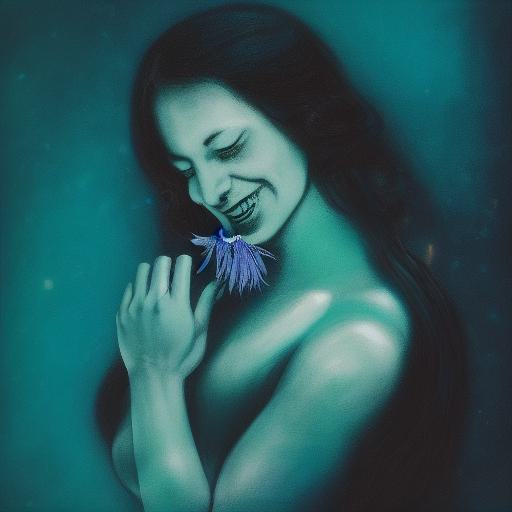How to write this prompt?
Here’s a breakdown of the prompt:
- Subject: The subject of the image is a woman in a low angle view. This indicates that the viewer is looking up at the woman, which can create a sense of power or dominance.
- Action: The woman is holding a laughing flower in her hand. This creates a sense of playfulness and whimsy.
- Style: The artwork is captured in a teal and indigo tinted color scheme, which creates a moody and mysterious ambiance. This color scheme is often associated with psychedelic art, which can convey a sense of otherworldliness.
- Technology: The painting is rendered using the Quixel Megascans technology, which gives a highly detailed and realistic feel to the subject and the surrounding environment. This can create a sense of depth and immersion in the image.
- Lighting: The lighting is accentuated with glowing radioactively and fluorescent lighting, giving a sci-fi twist to the artwork. This can create a sense of futuristic technology and otherworldly environments.
Overall, each individual part of the prompt contributes to the final image in a unique way. The subject and action create a sense of emotion and character, while the style and technology create a sense of environment and immersion. The lighting adds an extra layer of atmosphere and can create a sense of sci-fi or otherworldliness. By carefully crafting each element of the prompt, it’s possible to generate a highly detailed and unique image using AI technology.
What is Quixel Megascans technology and how does it work?
Quixel Megascans technology is a software tool that allows artists to create highly realistic and detailed 3D models and textures for use in digital art and media. It works by scanning real-world objects and surfaces using advanced imaging techniques, then converting that data into digital assets that can be easily used in various software programs.
Why is the teal and indigo color scheme often used in psychedelic art?
The teal and indigo color scheme is often used in psychedelic art because it can create a sense of otherworldliness and mystery, which is a common theme in the genre. These colors are also often associated with spiritual or metaphysical concepts, which can add to the overall feeling of the artwork.
Who are some famous artists known for creating psychedelic art?
Some famous artists known for creating psychedelic art include Alex Grey, Robert Venosa, and Mati Klarwein. These artists are known for their use of vibrant colors, intricate patterns, and surreal imagery, which are all common elements of psychedelic art.
How can AI-generated art be used in different industries?
- Advertising and Marketing: AI-generated art can be utilized in advertising and marketing campaigns to create visually striking and attention-grabbing imagery. It can assist in designing captivating logos, posters, and banners that align with brand aesthetics and convey the desired message.
- Entertainment and Media: AI-generated art can enhance the visual effects in movies, television shows, and video games. It can generate realistic environments, characters, and special effects, reducing the need for extensive manual labor in the creation process.
- Interior Design: AI-generated art can aid interior designers in visualizing and presenting design concepts. It can generate digital representations of spaces with different color schemes, furniture arrangements, and artwork, helping clients envision the final result.
- Fashion and Apparel: AI-generated art can be used to create unique patterns, textures, and designs for fabrics and garments. It can assist designers in experimenting with various combinations and generating fresh and innovative ideas.
- Architecture and Real Estate: AI-generated art can help architects and real estate developers by creating realistic 3D visualizations of buildings and landscapes. It can generate virtual tours, allowing clients to experience the design before construction begins.
What is the future of AI art generation?
- Advancements in Creativity: AI art generation algorithms are continuously improving, and future developments may enable AI systems to generate even more creative and original artwork. They could potentially produce art that surpasses human imagination and pushes the boundaries of artistic expression.
- Collaboration between AI and Artists: The future of AI art generation is likely to involve collaboration between AI systems and human artists. Artists can leverage AI tools to augment their creative process, using AI-generated suggestions and ideas as a starting point for their own artistic exploration.
- Democratization of Art: AI art generation has the potential to democratize art by making it more accessible and inclusive. AI tools can empower individuals with limited artistic skills to create visually appealing artwork, expanding the pool of artists and fostering creativity among a broader population.
- Ethical Considerations: As AI art generation becomes more prevalent, ethical considerations will arise regarding issues such as copyright, ownership, and authenticity. Discussions and regulations may be necessary to address these concerns and ensure fair practices in the creation and distribution of AI-generated art.
- Integration with Other Technologies: AI art generation can intersect with other emerging technologies, such as virtual reality (VR) and augmented reality (AR). This integration may enable immersive artistic experiences, where viewers can interact with AI-generated artwork in virtual or mixed reality environments.
Overall, the future of AI art generation holds tremendous potential to transform various industries, push artistic boundaries, and shape new modes of artistic expression. It will likely continue to evolve and spark both excitement and critical discussions about the intersection of AI and creativity.
Visualize your ideas like never before with the power of AI-generated art and design tools from Visual Paradigm Online. Elevate your designs to the next level by effortlessly integrating stunning graphics with just a few clicks. With a user-friendly interface and a vast selection of design templates and assets at your disposal, you can explore and experiment with various styles and layouts until you create the perfect masterpiece. Discover the limitless potential of AI-generated art and transform your creative vision into reality with Visual Paradigm Online.


